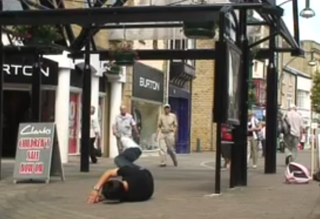Bystander Effect
To Be or Not to Be a Bystander?
Would you have helped James Bulger?
Posted August 1, 2021 Reviewed by Tyler Woods
Key points
- Two-year-old James Bulger was tortured and murdered by two 10-year-old boys.
- Thirty-eight witnesses reported seeing James injured and crying, yet none intervened to save his life.
- The bystander effect may have been the reason so many eye-witnesses did not take action.
"At bottom, propriety is concern for other people. When that goes out the window, the gates of hell are surely opened." —Jane Austen
The brutal murder of two-year-old James Bulger by two 10-year-olds, Robert Thompson and Jon Venables, still haunts Britain. The latest film on the murder, Lost Boy, shown recently on national television, triggered the familiar outrage and recurring questions. How could 10-year-old children do this? Were they born killers? Were they victims of their brutal home lives? Did the violent media they both devoured play a part?

But there’s another question that gets far less attention. Why did no one intervene to help James?
There were enough opportunities. James was abducted from a crowded Liverpool shopping mall. Visibly injured, and often crying, he was pushed and pulled through busy streets in broad daylight for two and a half hours before Thompson and Venables led him up a steep embankment to some rough ground near the railway line and beat him to death with an iron bar.
Most of the 38 witnesses who were brave enough to come forward and give evidence, said that they had noticed the fresh injury on James' forehead (caused by Thompson dropping him on his head) and that he seemed very upset. Some actually saw him being kicked and punched and pulled back by one of the older boys as he tried to run away.
Yet none of them did enough to save him. Why?
The Bystander Effect
The bystander effect occurs when the presence of others discourages a person from intervening in a situation that is, or may be, an emergency. Latané and Darley’s ground-breaking experimental research demonstrated that the more people present in a room, the less likely it was a person would get up and investigate a possible emergency, such as someone calling for help from a nearby room.

I was initially skeptical that these results would be found in the real world. But sadly, they are. Making a film, Bystander Intervention, we had a student feign a collapse in a busy shopping mall and filmed the reactions of the public. Of the shoppers who clearly saw the student, only one in every 25 stopped to see if they could help. More dramatically, when Bill Stanton staged the kidnapping of a 7-year-old actress in New York, dragging her across the street as she screamed for help, bystanders either stood watching or hurried away.
Latané and Darley attributed the bystander effect to two factors: diffusion of responsibility and social influence. Diffusion of responsibility argues that the more onlookers there are, the less personal responsibility an individual will feel to become involved. Social influence refers to the fact, that individuals tend to adapt their behavior to fit in with those around them.
But while the bystander effect helps to explain the lack of positive action that could have saved James Bulger, it only tells us part of the story because it’s limited to the physical presence, or absence, of others. We also have to look at the social meanings inherent in non-intervention.
To Act or Not to Act?
Professor Mark Levine of Lancaster University studied the evidence given by the 38 witnesses at the trial of Thompson and Venables. He found a more complex reaction than simple bystander apathy.
A number of witnesses were concerned, some very concerned, when they saw James. However, they were then reassured because they believed, or were told, that the boys were brothers.
"I got up to go over to him," said one witness, "But then I saw the older boys. I thought that's okay then, he’s with his brothers."
Not only were witnesses reassured by thinking that James was in the care of his siblings, but there was also a question of whether they had the authority to get involved. Another witness was asked why she hadn't inquired further about James' injuries.
"Well, I automatically thought they were family, didn't I?" she replied, as if it was obvious.
"There is something about the category of family," says Levine, "that often appears to rule out intervention on the part of non-family members. The family is seen as a private area that many people feel they don’t have the right to intrude into."
Venables and Thompson were quick to exploit this. One of the last witnesses to see James alive was a man on his way home from work.
"What's up with the little fella?" he asked, bending down to look at James.
Venables told him he’d fallen over and that he was fed up with having to look after his little brother.
"I’m going to tell my mum I’m not having him no more," he said.
Reassured, the man continued on his way home.
It was just a few minutes later that Thompson and Venables dragged James up the grassy bank to his death
From Bystander to Participant
So, how might we move from being a passive bystander to an active participant?
- Research has shown that bystanders are more likely to help if they identify with a victim. So, imagine the person you think is in danger is your child, your mother, or your best friend. Ask yourself what you would do then.
- Once you’ve noticed someone in danger and you’re in a position to help, tell yourself this is now your responsibility. Don’t take refuge behind the fact that there are other people there.
- Don’t be influenced by what others are doing, or not doing. Be an influence. Try to get others on board. For example, just shouting out something like, "Stop it!" or, "The police have been called," can break the ice and galvanize others into action.
- If you are powerless to intervene directly, call the emergency services. If you feel that the official you’re talking to doesn’t seem to be taking your concerns seriously enough, ask for their name and tell them you want it put on record the person you’re concerned about is 'at risk.’ The words at risk, with their implications of inquiry and possible legal action, are very powerful and usually trigger action.
- Remember a lot of cruelty and violence is intra-familial. So don’t be put off intervening, as some of the Bulger witnesses were, just because you think the people involved are from the same family.
- The more we show 'proprietorial concern for others' and become participants rather than bystanders when we think someone may be at risk, the more likely it is we can help prevent tragedies like the appalling death of James Bulger, a tragedy that "opened the gates of hell" and left the witnesses who saw James wishing they’d done something to help him for the rest of their lives.




